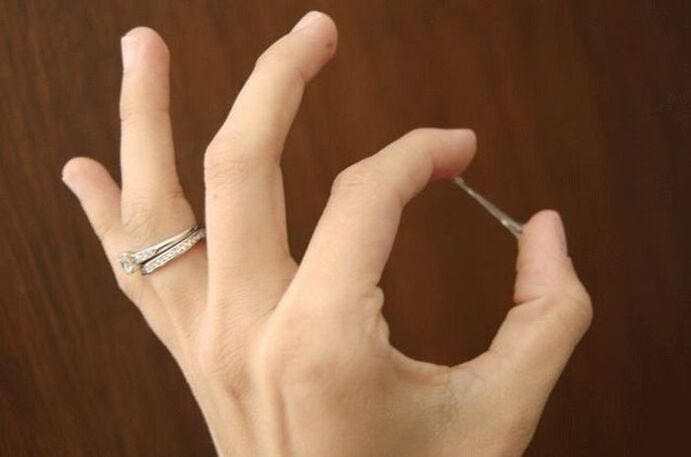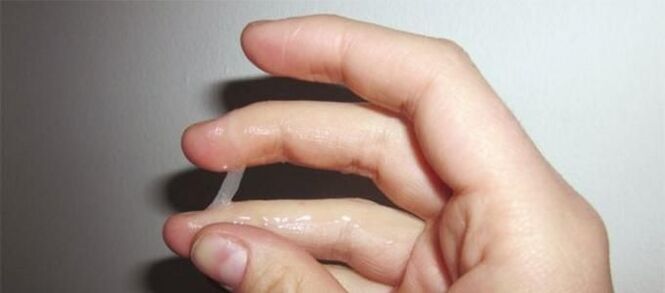The appearance of sexual desire in women is accompanied by swelling of the mammary glands and the release of lubricant. But few people know what men release when they are excited. The stronger sex is able to produce not only seminal fluid, but also a special lubricant that facilitates sliding during friction.

Male arousal mechanism
The process of sexual arousal is a complex psychological and physiological response. In most cases, sexual attraction begins with eye contact with the object of desire. The image of the upcoming sexual intercourse appears in the subconscious of a man, which causes an erection.
Not only real images, but also fantasy images can arouse sexual desire. This reaction may be slower. Erectile function depends on the response of the central nervous system. Male sexual ability is controlled by brain impulses that pass through the spinal cord.
The main mechanism of attraction is thoughts and self-images born of fantasy.
Types of erections and their mechanisms:
- Reflex. This reaction occurs after stimulation of the genital organs. The response is physiological and often appears within a minute of masturbation. This mechanism originates from the spinal cord. Sexual desire can be observed even in paralyzed people with spinal injuries.
- Psychogenic. This is a stimulus mechanism caused by fantasy and thought processes. Sexual images associated with the possibility of sexual intercourse appear in men's heads. This type of erection requires a healthy nervous system, as only some patients with lower spinal cord injuries can achieve it.
- night. Refers to mechanical uncontrollable erections, occurring in all healthy men. The first night reaction of sexual stimulation is observed even in boys during puberty. The absence of a mechanical erection is a reason to consult a doctor and is a sign of androgen deficiency and other physiological disorders.
The penis becomes hard after the penis is filled with arterial blood. Men may experience discharge when they are excited. At the same time, the ischiocavernosus muscle contracts, compressing the base of the penis and preventing the outflow of blood from it. During this period, urination is difficult.
After contraction along the epididymis, ejaculation occurs - seminal fluid is expelled from the urethra. The bladder neck also contracts, preventing the backflow of secretions, then the penile muscles contract sharply and rhythmically, releasing 2 to 5 ml of ejaculate.
After ejaculation, a man completely loses sexual desire and the hardness of the genital organs disappears. In this case, for some time, erection becomes impossible, and the formation of seminal fluid continues.
A healthy man may experience sexual response again within 10 minutes. However, this period varies and depends on the man's sexual habits and desires. Age, health and mental state play an important role.

What is precum
When aroused, men secrete clear mucus - this is pre-ejaculation. It appears with or after an erection. The release of the fluid helps prevent injury to the penis during vaginal penetration.
The absence of pre-ejaculation in a man may indicate a pathology of the reproductive system.
The secreted substance is also often called pre-seminal fluid. There is another name - pre-seed. This lubricant is released not only before sexual intercourse, but also during slight sexual stimulation, during caressing and masturbation. The appearance of pre-ejaculation indicates the desire of a man to have an intimate relationship with a woman.

Where is it produced?
Lubrication secretion in a man cannot be called a simple process. The body has a special gland located in the perineal muscle, at the base of the penis. They are called Cooper's or bulbourethral glands.
Male organs received their name in honor of the discoverer, Cooper. They were discovered in the 17th century, but the true purpose of glandular tissue was known later.
There is also Littre's gland, where the pre-ejaculatory part is formed. They are located in the urethra (from the neck of the bladder to the external opening of the urethra). Their main task is to secrete alkaline mucus fluid, thereby increasing the amount of pre-seminal fluid. Usually, it ranges from 2-3 drops to 5 ml.
The most common reason to visit the doctor is pre-ejaculation at the slightest sexual stimulation. Such signs may indicate damage to the genitourinary system and cause problems. However, this condition can be treated. Andrologists prescribe therapy after appropriate examination.

Compound
Pre-seminal fluid is a mucus secretion that contains alkali and various enzymes. Since the vaginal environment is acidic and repels male semen, lubricants help neutralize the "aggressiveness" of female microflora.
There is a myth that discharge from the male urethra can cause women to become pregnant. Lubricant does not contain sperm, but it may be present when unprotected intercourse occurs within hours of masturbation or previous intercourse.
To avoid unwanted pregnancy, in this case it is recommended to use condoms or other means of protection.

Function
Pre-semen is not only a transparent liquid lubricant, but also a protective reaction of the mucous membrane. Pre-ejaculate facilitates the penetration of the penis into the vagina and helps reduce friction if the woman does not produce enough lubrication.
Penile secretions have several important functions:
- neutralize the increased acidity of the vaginal microflora,
- facilitate penetration of the penis, help the movement of sperm along the cervix,
- increase the chances of getting pregnant,
- release the contents of the urinary tract (urine, semen).
Sperm die quickly in an acidic environment. And it is thanks to the alkaline pre-ejaculate that they can enter the female genital tract without damage and fertilize the egg. This is why male lubricant can protect sperm viability.
Discharge from the urethra also increases the chances of pregnancy, as the seminal fluid will quickly enter the uterus when sliding. In addition, natural lubricants will help avoid the use of artificial substitutes and facilitate the penetration of the penis into the vagina if the woman does not have enough of her own secretions.

What does normal look like?
In medical terms, urethral discharge is often called libidinal urethrorrhea. In appearance, it is a normal transparent slime. During sex, it is released in the amount of 1 to 5 ml. This amount is enough for comfortable sexual intercourse.
Pre-semen also contains smegma, a fatty substance that accumulates in the folds of the foreskin. If a man is faithful to one sexual partner or uses a condom during sexual intercourse, then there is no additional entry or color change. A slight whitish color is possible.

Because see the doctor
The appearance of any suspicious symptoms is a reason to consult a doctor. Such changes in the body should alert you. If a man consults a doctor in time, the disease can be detected at an early stage, which contributes to a quick recovery.
These symptoms will be an indication and a reason to examine the body for the presence of infection or inflammatory diseases of the genitourinary system. The doctor will prescribe diagnostic examinations and laboratory tests to identify the cause of the development of the pathological process.
Additional symptoms that will help make a diagnosis:
- increased body temperature, fever, fever,
- pain or discomfort in the pelvic organs,
- redness of the skin, rash and tissue swelling,
- purulent and bloody impurities in the discharge,
- itching and burning in the urethra,
- hyperemia in the penile area,
- other suspicious symptoms (urinary retention, erectile dysfunction).
The same pathological process in the male body during pleasure and during the rest period is observed when infected with sexually transmitted diseases. If you notice one or more of the accompanying symptoms, consult your doctor immediately. Immediate antibiotic therapy may be required.
No pre-cum released
Some men, after reading the article, may suspect a problem because they do not produce pre-ejaculation. This can be either a normal sign or a sign of a pathological process.
The volume shown (1 to 5 ml) is approximate. The amount of discharge from the urethra during stimulation can vary and depends on the individual characteristics of the body. Sometimes a man does not notice the discharge of lubricant, because it is released after penetration into the vagina.
In 5% of cases, the absence of pre-ejaculation is a symptom of the presence of an inflammatory disease. You are advised to consult your doctor about possible problems. Disabled and elderly people may not experience discharge from the urethra.

Change in color and consistency
Any colored splash should alert a man. Usually, the color of pre-semen is transparent, slightly white. You should also pay attention to density. Pre-seminal fluid is thin and flows freely from the urinary tract during sexual stimulation.
Reasons to see a doctor:
- odor changes, the appearance of an unpleasant "fishy" smell mixed with mold,
- increased emissions,
- the presence of blood and pus,
- changes in pre-ejaculate structure, thickening, appearance of cheesy sediment,
- color change.
Gray, red, green, orange and other colors are signs of an inflammatory or infectious process. The body reacts in this way to the invasion of viruses. Sometimes colored discharge is a sign of the normal recovery process after prostate surgery, antibiotic therapy or other surgical interventions.
Clear, sticky discharge sometimes indicates infection with infectious diseases: staphylococcus, streptococcus, E. coli. The release of bacteria is observed not only in pre-semen, but also in the resting state of the penis.
What does the appearance of different pre-seminal colors mean:
- Gray-green color. Indicates the presence of infection in the body. This is not always a sign of venereal disease; influenza or ARVI can manifest itself in this way. As a rule, it is accompanied by an increase in body temperature.
- Thick whiteness. They are talking about the development of a fungal disease, most often it is candidiasis. It is spread from an infected sexual partner. If the pathogen is detected, both men and women must be treated.
- Red colour. Indicates the presence of blood in the discharge. These symptoms are typical for urological diseases (urethritis, cystitis), chronic prostatitis and some other diseases not related to the urinary system: hypertension, atherosclerosis.
- Yellow. This is a sign of a sexually transmitted infection. Men rarely show symptoms of STDs; often this disease occurs in a latent form. When yellow discharge appears, chlamydia, ureaplasmosis, mycoplasmosis and other sexually transmitted diseases can be suspected.
- Purulent discharge. They talk about the presence of certain types of infections, such as gonorrhea, syphilis, and gonococcal infections. Often accompanied by urinary problems and erectile dysfunction.
Only a doctor can make an accurate diagnosis. Routine checks are not enough to identify the problem; you need to undergo laboratory diagnostics, in some cases using ultrasound.
The key to recovery is timely consultation with a doctor.
Do not self-medicate and do not let the disease linger. Sexually transmitted diseases cause the appearance of many pathologies and can cause problems with urination, erectile dysfunction and a decrease in the body's immune defenses.

























